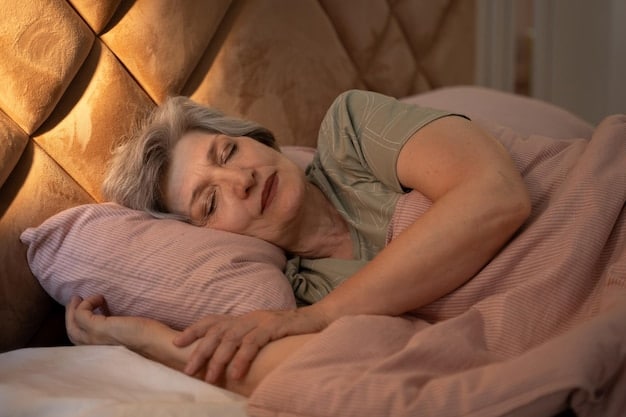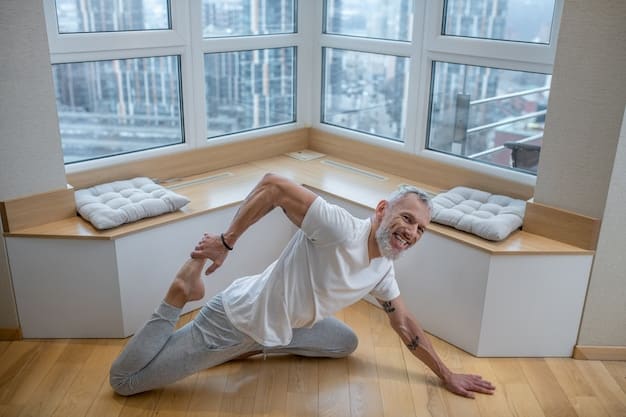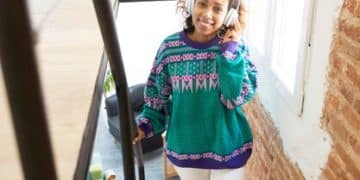Boost Senior Sleep with 2025 Hygiene Tips

To improve sleep quality, seniors in 2025 should integrate updated sleep hygiene techniques focusing on personalized routines, advanced environmental controls, and data-driven behavioral adjustments, moving beyond traditional advice to embrace holistic and technologically supported methods for restorative rest.
As we navigate the complexities of aging, one foundational pillar of well-being often comes into sharp focus: sleep. For many seniors, achieving consistent, restorative sleep can feel like an elusive goal. However, understanding How Can Seniors Improve Sleep Quality with Updated Sleep Hygiene Techniques in 2025? is not merely about adjusting habits; it’s about embracing a dynamic and proactive approach to rest that leverages both timeless wisdom and emerging innovations.
Understanding the Evolving Landscape of Senior Sleep
Sleep patterns naturally shift with age, leading to common complaints such as difficulty falling asleep, frequent awakenings, and less consolidated sleep. While these changes are part of the aging process, they are not insurmountable obstacles to quality rest. Recognizing these physiological shifts is the first step toward implementing effective sleep hygiene strategies that are tailored for seniors.
In 2025, the conversation around senior sleep hygiene extends beyond the familiar advice of a quiet, dark room and a regular bedtime. It now encompasses a more nuanced understanding of how interconnected factors—from hormonal changes and medication side effects to lifestyle choices and even technology—impact a senior’s ability to achieve truly restorative sleep. The multidisciplinary nature of sleep science means that improvements often come from addressing several areas concurrently.
Physiological Changes and Their Impact
- Circadian Rhythm Shifts: Many seniors experience a phase advance, meaning they tend to get sleepy earlier in the evening and wake up earlier in the morning.
- Decreased Deep Sleep: The proportion of deep, slow-wave sleep (NREM stage 3) reduces with age, which is crucial for physical restoration and memory consolidation.
- Increased Sleep Latency and Fragmented Sleep: It often takes longer for seniors to fall asleep, and they tend to wake up more frequently throughout the night, leading to less continuous sleep.
Addressing these physiological realities requires a tailored approach. For example, understanding the shift in circadian rhythm can help seniors adjust their evening routines to align more naturally with their body’s inherent clock, potentially making it easier to fall asleep and stay asleep. Modifying daily activities to include more natural light exposure during the day can also help regulate the body’s internal clock.
The reduction in deep sleep, while a natural part of aging, underscores the importance of maximizing the quality of the sleep obtained. This often involves reducing disruptions and optimizing the sleep environment to support longer periods of undisturbed rest. Furthermore, consulting with healthcare professionals about specific age-related sleep disorders, such as sleep apnea or restless legs syndrome, is crucial. These conditions can significantly impair sleep quality and require medical intervention rather than just lifestyle adjustments.
Personalizing Your Sleep Routine: Beyond the Basics
Generic sleep advice often falls short for seniors, whose needs are diverse and unique. A truly effective sleep hygiene plan in 2025 must be highly personalized, taking into account individual health conditions, daily routines, and personal preferences. This involves a keen focus on consistency, adaptability, and understanding one’s own body signals.
Creating a consistent bedtime and wake-up schedule, even on weekends, is a cornerstone of good sleep hygiene. This consistency helps to reinforce the body’s natural sleep-wake cycle, making it easier to fall asleep and wake up feeling refreshed. However, “consistent” doesn’t mean rigid; it means finding a rhythm that works for your body and sticking to it most of the time.
Tailoring Your Pre-Sleep Rituals
- Mindful Wind-Down: Dedicate 30-60 minutes before bed to calming activities. This could be reading a physical book, listening to soothing music, or engaging in gentle stretching or meditation.
- Warm Bath or Shower: A warm bath or shower before bed can help lower body temperature after you get out, signaling to the body that it’s time to sleep.
- Light Snack if Needed: If hunger interferes with sleep, a light, complex carbohydrate snack (like a small banana or whole-grain crackers) might be helpful, but avoid heavy meals close to bedtime.
Personalization also extends to the type of light exposure. While bright light exposure during the day is beneficial, specific types of light therapy may be considered under medical guidance to help reset circadian rhythms in some cases. Furthermore, understanding the impact of medications on sleep is vital. Many common drugs can affect sleep architecture; a review with a healthcare provider can identify potential culprits and explore alternatives or timing adjustments.
The concept of “sleep banking” or catching up on sleep during weekends is largely a myth for seniors. While an occasional extra hour might not hurt, significant deviations from the routine can disrupt the circadian rhythm, similar to jet lag. Instead, prioritizing consistent, sufficient sleep during the week is more beneficial. Incorporating brief, strategic naps might be an option for some, but these naps should be short (20-30 minutes) and taken earlier in the day to avoid interfering with nighttime sleep.

Optimizing the Sleep Environment with Smart Solutions
The bedroom environment plays a pivotal role in sleep quality. For seniors, this is especially true, as they may be more sensitive to light, noise, and temperature fluctuations. In 2025, optimizing the sleep environment increasingly involves smart technologies and thoughtful design choices that promote uninterrupted rest.
Beyond the traditional advice of a dark, quiet, and cool room, consider the integration of smart home devices that can automate these conditions. Smart lighting systems can gradually dim in the evening and brighten in the morning, mimicking natural light cycles. Smart thermostats can maintain an optimal sleep temperature, and white noise machines can mask disruptive sounds without being distracting.
Advanced Environmental Control Techniques
- Smart Lighting for Circadian Rhythm: Use smart bulbs that adjust color temperature throughout the day, emitting cool, bright light in the morning and warm, dim light in the evening to support melatonin production.
- Temperature Regulation Systems: Advanced mattresses with integrated cooling/heating or smart thermostats can maintain an ideal sleep temperature (typically 60-67°F or 15-19°C), which is crucial for sleep onset and maintenance.
- Noise Cancellation and Soundscapes: High-quality earplugs or active noise-canceling devices can block external disturbances. Alternatively, sound machines offering nature sounds or customizable white noise can create a calming auditory environment.
Consider also the quality of your bedding. Pillows and mattresses lose their supportive qualities over time. Investing in a mattress that provides adequate pressure relief and spinal alignment, and pillows that support the neck and head comfortably, can significantly reduce physical discomforts that disrupt sleep. Hypoallergenic options are also important for those with allergies or breathing sensitivities.
Reducing blue light exposure in the evening is also critical. Electronic devices like smartphones, tablets, and computers emit blue light that can suppress melatonin production, making it harder to fall asleep. Implementing a “digital sunset” at least an hour before bedtime, where all screens are turned off, can significantly improve sleep readiness. For those who must use screens, blue light filtering glasses or software settings can help mitigate some of the negative effects.
Nutrition, Hydration, and Medications: A Holistic View
What you consume, and when, directly influences your sleep. For seniors, metabolic changes and medication interactions make this aspect of sleep hygiene particularly important. A holistic approach considers how diet, hydration, and pharmaceutical regimens intersect with sleep quality.
Avoid heavy meals, especially those high in fat or spice, close to bedtime. These can lead to indigestion and discomfort, disrupting sleep. Similarly, limit caffeine and alcohol intake, particularly in the afternoon and evening. While alcohol might initially induce drowsiness, it often leads to fragmented sleep later in the night as the body metabolizes it.
Dietary Adjustments for Better Sleep
- Mindful Caffeine Consumption: Understand your individual sensitivity to caffeine. For many seniors, avoiding caffeine after noon is advisable.
- Strategic Hydration: Stay well-hydrated throughout the day, but reduce fluid intake in the few hours leading up to bedtime to minimize nighttime bathroom trips.
- Nutrient-Rich Diet: Focus on a balanced diet rich in whole foods. Some nutrients like magnesium, calcium, and certain B vitamins are associated with better sleep. Consult a doctor or dietitian before making significant dietary changes or taking supplements.
Medications are a significant factor in senior sleep. Many commonly prescribed drugs, including some for blood pressure, heart conditions, depression, and pain, can affect sleep either by causing insomnia or excessive daytime sleepiness. It is crucial to have an open conversation with your doctor or pharmacist about your sleep patterns and any medications you are taking. They can assess potential side effects and explore alternative medications or adjust dosing schedules to minimize sleep disruption.
Herbal remedies and supplements for sleep should be approached with caution and always discussed with a healthcare professional. While some studies suggest benefits for ingredients like valerian root, chamomile, or melatonin, their efficacy can vary, and they may interact with other medications. Individual responses differ greatly, and what works for one person may not work for another, or might even cause adverse effects.
Activity and Social Engagement: Beyond Physical Exercise
Regular physical activity is broadly recognized for its benefits to sleep. However, for seniors, the scope of “activity” extends beyond structured exercise to include daily movement, mental stimulation, and social engagement, all of which contribute significantly to healthy sleep patterns.
Engaging in moderate physical activity during the day can promote deeper sleep at night. This doesn’t necessarily mean intense workouts. Activities like walking, swimming, gardening, or gentle yoga can be highly effective. The key is consistency and avoiding vigorous exercise too close to bedtime, as it can be stimulating rather than calming.
Holistic Approaches to Daily Activity
- Morning Light Exposure and Activity: Combining morning activity with exposure to natural light helps to reinforce the circadian rhythm, sending a strong signal to the body that it’s daytime.
- Cognitive Engagement: Keeping the mind active through puzzles, learning new skills, reading, or engaging in stimulating conversations can reduce anxiety and promote mental well-being, which indirectly supports better sleep.
- Social Connection: Regular social interaction helps combat loneliness and depression, common issues that can negatively impact sleep quality. Participating in community groups, spending time with family, or volunteering can provide valuable social outlets.
The impact of daytime activity on nighttime sleep is profound. Being sedentary throughout the day can make it harder for the body to differentiate between wakefulness and sleep. Conversely, a day filled with purpose and moderate physical and mental exertion creates a natural inclination for rest. This aligns with the body’s natural need for recovery after periods of activity.
For seniors with mobility limitations, adapted exercises or chair yoga can still provide significant benefits. Even small increases in daily movement, such as walking around the house or performing gentle stretches, contribute to overall well-being and can positively influence sleep. The goal is to avoid prolonged periods of inactivity, particularly during daylight hours.
Addressing Underlying Conditions and Seeking Professional Help
While good sleep hygiene is fundamental, it’s essential to recognize when sleep difficulties stem from underlying medical conditions or require professional intervention. Many sleep disorders become more prevalent with age, and addressing them is crucial for lasting improvement in sleep quality.
Common sleep disorders in seniors include sleep apnea, restless legs syndrome, and insomnia. Sleep apnea, characterized by pauses in breathing during sleep, can lead to chronic fatigue and other health issues. Restless legs syndrome causes an irresistible urge to move the legs, often disrupting sleep. Chronic insomnia, defined as difficulty sleeping for at least three nights a week for three months or more, often requires targeted behavioral therapies.
When to Consult a Healthcare Professional
- Persistent Insomnia: If difficulties falling or staying asleep persist despite implementing sleep hygiene techniques.
- Excessive Daytime Sleepiness: Feeling uncontrollably sleepy during the day, even after what seems like adequate sleep.
- Loud Snoring or Breathing Pauses: These could be signs of sleep apnea, which requires medical diagnosis and treatment.
- Unusual Leg Sensations: An undeniable urge to move legs, especially at night, may indicate restless legs syndrome.
A sleep specialist can conduct a comprehensive evaluation, which may include a sleep study (polysomnography), to accurately diagnose the root cause of sleep problems. Treatment options vary widely depending on the diagnosis and can range from Continuous Positive Airway Pressure (CPAP) for sleep apnea to lifestyle modifications, medication adjustments, or cognitive behavioral therapy for insomnia (CBT-I).
CBT-I is often considered the first-line treatment for chronic insomnia and is highly effective for seniors. It’s a structured program that helps individuals identify and replace thoughts and behaviors that hinder sleep with habits that promote sound sleep. Unlike sleeping pills, which may have side effects and become less effective over time, CBT-I provides long-term strategies for managing insomnia. Understanding that sleep is a complex process influenced by a myriad of factors allows for a more effective and comprehensive approach to improving its quality in older age.
Embracing Technology and Data for Smarter Sleep
The year 2025 brings exciting advancements in wearable technology and smart devices that can offer valuable insights into sleep patterns. While not a replacement for professional medical advice, these tools can empower seniors to become more informed about their sleep and identify personalized strategies for improvement.
Sleep trackers, whether worn on the wrist or integrated into the bed, can monitor various metrics such as sleep stages (light, deep, REM), heart rate, breathing, and movement throughout the night. Analyzing this data over time can reveal patterns and help pinpoint habits that contribute to or detract from sleep quality. For example, a tracker might show that late-night meals consistently lead to fragmented deep sleep.
Leveraging Digital Tools for Sleep Enhancement
- Wearable Sleep Trackers: Devices like smartwatches or dedicated sleep monitors can provide objective data on sleep duration, quality, and consistency, aiding in personalized habit adjustments.
- Sleep Meditation Apps: Utilize apps offering guided meditations, progressive muscle relaxation, or soothing soundscapes designed to calm the mind and facilitate sleep onset.
- Smart Alarm Clocks: Alarms that wake you during a light sleep stage can reduce grogginess and improve morning alertness, making the transition from sleep more natural.
However, it’s important to approach sleep tracking with a balanced perspective. The data should serve as a guide, not a source of anxiety. Over-obsessing about sleep metrics can sometimes lead to “orthosomnia,” where the pursuit of perfect sleep data ironically contributes to anxiety and worse sleep. The goal is to use the information to make informed adjustments to your routine and environment, not to achieve an impossible ideal.
Furthermore, digital platforms are increasingly offering tailored programs and resources for seniors specifically. These can include educational content on age-related sleep changes, guided exercises, and community forums for shared experiences and support. Leveraging these resources, under the guidance of healthcare professionals when necessary, can significantly enhance a senior’s ability to navigate their unique sleep challenges and implement effective, evidence-based strategies for better rest.
Maintaining Long-Term Sleep Health: A Dynamic Process
Improving sleep quality is not a one-time fix but an ongoing journey. For seniors, maintaining long-term sleep health requires continuous adaptation, self-awareness, and a willingness to adjust strategies as circumstances or health conditions evolve. The principles of updated sleep hygiene are about fostering a sustainable approach to rest that supports overall well-being.
Regularly reassessing your sleep patterns and the effectiveness of your hygiene techniques is vital. What worked perfectly a few months ago might need tweaking today due to changes in medication, activity levels, or even seasonal light exposure. Think of it as a dynamic process rather than a static checklist.
Key Principles for Sustainable Sleep Health
- Regular Review with Healthcare Providers: Discuss your sleep at routine check-ups. This helps catch potential issues early and allows for timely adjustments to treatment plans or lifestyle advice.
- Adaptability and Flexibility: Be prepared to modify your sleep routine as life evolves. Travel, illness, or changes in living arrangements may require temporary adjustments to maintain sleep quality.
- Continued Learning: Stay informed about new research and recommendations in sleep science, particularly those relevant to aging.
Cultivating a positive mindset about sleep also plays a significant role. Anxiety about not sleeping often perpetuates the problem. Instead, focusing on creating a relaxing bedtime routine, even if sleep doesn’t immediately follow, can reduce pressure and promote a more conducive environment for rest. It’s about letting go of perfectionism and embracing consistent effort.
Finally, remember that good sleep is deeply intertwined with overall health. By prioritizing sleep hygiene, seniors are not just improving their nights but enhancing their days, leading to better mood, cognitive function, physical health, and overall quality of life. The updated techniques available in 2025 offer more tools and insights than ever before, empowering seniors to take control of their sleep and unlock its profound benefits.
| Key Aspect | Brief Description |
|---|---|
| ⏰ Personalized Routines | Tailoring consistent sleep schedules and relaxing rituals for individual needs and preferences. |
| 💡 Smart Environment | Utilizing advanced lighting, temperature, and noise control to optimize the bedroom for sleep. |
| 🍎 Holistic Health | Considering diet, hydration, physical activity, and medication interactions for better sleep. |
| 📈 Data & Professional Help | Leveraging sleep trackers and consulting specialists for persistent issues and underlying conditions. |
Frequently Asked Questions About Senior Sleep
▼
Seniors frequently experience sleep problems due to natural age-related physiological changes, such as reduced deep sleep and shifts in circadian rhythms. Additionally, medical conditions, medications, and lifestyle factors common in older age can contribute to difficulties like insomnia or fragmented sleep patterns. Understanding these underlying causes is key.
▼
Yes, blue light exposure, especially from electronic screens in the evening, significantly affects sleep quality for seniors. Blue light suppresses melatonin production, a hormone essential for sleep, making it harder to fall asleep and disrupting the natural sleep cycle. Limiting screen time before bed is a crucial updated hygiene technique.
▼
Room temperature is highly important for senior sleep, as the body’s core temperature needs to drop slightly for sleep onset. An overly warm room can interfere with this process, leading to discomfort and fragmented sleep. An optimal bedroom temperature, typically between 60-67°F (15-19°C), is largely considered ideal for restful sleep.
▼
Napping habits can be both beneficial and detrimental for seniors, depending on their duration and timing. Short, strategic naps of 20-30 minutes taken earlier in the afternoon can be restorative. However, long or late-afternoon naps can disrupt nighttime sleep by reducing sleep drive, making it harder to fall asleep when bedtime arrives.
▼
A senior should seek professional help for sleep issues if difficulties persist despite implementing good sleep hygiene techniques. This includes chronic insomnia, excessive daytime sleepiness, or symptoms of sleep disorders like sleep apnea (loud snoring, breathing pauses) or restless legs syndrome. A sleep specialist can provide accurate diagnosis and tailored treatment.
Conclusion
In essence, mastering sleep quality for seniors in 2025 transcends simple advice, embracing a comprehensive, personalized approach that integrates evolving insights into sleep science. From fine-tuning individual routines and optimizing sleep environments with smart solutions to mindful diet choices and leveraging technology for data-driven insights, the path to restorative rest is dynamic. Recognizing the profound impact of physical activity and social engagement, while also understanding when to seek professional help for underlying conditions, collectively empowers seniors. By adopting these updated sleep hygiene techniques, older adults can significantly enhance their sleep, contributing to improved overall health, vitality, and an enriched quality of life in their later years.





